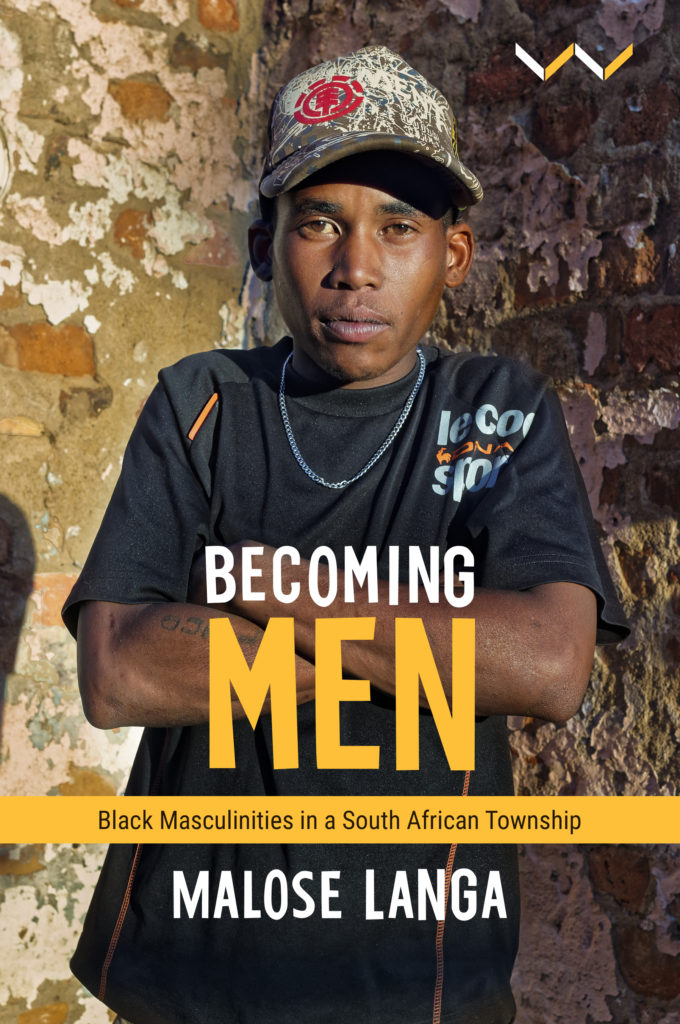Toxic masculinities help drive everything from HIV infection rates to gender-based violence. But before we ask, what does it mean to be a ‘man’ in South Africa, should we wonder what it’s like to be a boy?
COMMENT
“Is it important for a boy to satisfy a girl sexually?” I asked the group of young men sitting before me.
“To be in the crowd, it is,” Oupa piped up. “To be [a] popular boy, it is.”
Oupa thought of himself as a “sex-jaro” boy. Pointing to a photo he had taken of a school mate, another boy, Martin, explained the term.
“This guy is a sex-jaro,” Martin said, “a boy who likes girls. Like ‘jaro’… never fails in anything, there is no girl who can say no to him when he chats her up,” he continued. “That is why I tell you that this boy dates a girl today and then the next day he wants to have sex with her.”

We know little about how young, Black boys construct their masculine identities
There have been numerous studies done in South Africa on masculinities, many of them focusing on problems, including gender-based violence, HIV and substance abuse.
However, we know little about how young, Black boys construct their masculine identities, although international research suggests that stereotyped ideas that have dictated what it means “to be a man” are changing.
I wanted to explore this when it came to Black boys in a South African township. So in 2007, I began a study with a group of adolescent boys in Alexandra, one of South Africa’s oldest townships. At the time we met, they were all schoolboys between the ages of 13 and 18.
Over the next nearly 12 years, I would meet these boys regularly and watch them grow into young men. My aim was to explore how boys negotiated their transition to adulthood in the township and in doing so, observe how they understood what it means to be a “real” man and whether definitions of masculinity were static or fluid.
I also wanted to listen for voices of alternative masculinities — those that are non-risk taking, non-sexist and not harmful to self and others — and hear how adolescent boys in Alexandra felt about these ways of being a man.
The different ways of being a boy
All boys are not the same, the young men in my study told me. There were, for instance, sex-jaro boys (popular with girls), tsotsi boys (naughty/violent boys) and academic boys.
And, as argued in the 2001 book, Young Masculinities, most boys do not fit neatly into one category. Instead, young men in my study often vacillated between multiple groups of boys to conform to dominate narratives of what it meant to be a “real township boy” and in doing so accrue cultural and social capital.
Tsotsi boys — at the top of the masculine hierarchy at school — were described as those who missed classes, defied authority and bullied others. Being unruly and violent was described as a critical marker of being a tsotsi boy, and self-identified tsotsi boys were firm in the view that reputation and respect were gained only through fights with other boys.
Academics and alternative masculinities
In contrast, “academic boys” were those who followed the rules and got good grades.
The desire to do well academically, I realised in my research, was a significant protective factor in helping boys avoid risk-taking behaviours such as being involved with crime, violence or substance abuse. This finding mimics previous 2005 South African research featured in African Masculinities and as well as work done in Brazil and chronicled in the 2004 book, Dying to be Men: Youth, Masculinity and Social Exclusion. These boys were internally driven to do well in their studies and appeared to have a clear sense of their masculine self and generally displayed a high degree of self-reflection.
“Academic boys” also expressed significantly higher levels of optimism and confidence about the future than their “tsotsi” peers.
However, I found, as other researchers have, that there were costs to being an academic boy — including the perception that they were more likely to be rejected by girls for not being “masculine enough”.
So instead, some boys chose to navigate more than one space, or were “in-between”, as was Herman, who occasionally teased teachers but also made sure to do his homework. Herman thus employed a strategy to “save face”.
Academic boys who moved between groups and occupied multiple positions were also less likely to be bullied because they had the cultural and social capital to negotiate boundaries between groups without being seen as easy targets.
But many of the boys’ narratives — whether self-proclaimed tsotsis or not — revealed a perception that willingness to engage in violence was proof of being a “real” township boy.
In all the interviews, the use of violence was justified as a valid response to other boys’ provocations, including fights over girlfriends or teasing.

‘You must not look up to just one girl’
Having multiple sexual partners came up regularly in interviews as a key marker of successful township as well as sex-jaro masculinities. Disclosing to male peers one’s sexual “success” enhanced sex-jaro boys’ public status and acceptability.
However, successful masculinity included not only the ability to secure multiple sexual partners but also the capability to satisfy them sexually and in this way challenged traditional notions of masculinity, i.e. that sex is all about penetration and male orgasm.
At the same time, sex-jaro boys betrayed a somewhat surprising vulnerability, revealing fear and anxiety about intimate relationships centred on the possibility of girls leaving them and was part of their justification for engaging in several relationships simultaneously.
‘You must not look up to one girl,’ said one of the young men, Peter. ‘Look up to two girls – because if you have one, when she leaves you, you are going to be left with nothing.’
Therefore, some boys justified their need to have more than one girlfriend out of a fear of being hurt or abandoned. It seems boys perhaps feel more insecure and vulnerable in relationships than might be evident at face value, but conceal this fear of psychological distress by having multiple girlfriends — or a “back-up plan.”
How boys police girls’ bodies
In this study, it was evident boys were expected to cheat on girls but not the other way around. It was boys who should start and stop a relationship, boys said. Sex-jaro boys in the study felt justified in using girls as sex objects and having sex with different partners while denying girls the same freedom.
Such double standards endorse male supremacy and, in this study, resulted in adolescent boys actively policing girls’ behaviour, for example by ostracising and labelling them negatively if they did not conform to the expected gender norms.
But some young men — especially those that thought of themselves as academic boys — rejected a masculinity premised on multiple partners and instead embraced an alternative masculinity that promoted “faithfulness” and challenged misogynistic views of girls as sex objects. These boys said they believed that girls should be treated with respect and dignity.
Academic boy Simon took the moral position that boys should not tell girls that they loved them while knowing that they were betraying them by having other relationships. His chief complaint was that sex-jaro boys tarnished the image of “good” boys like him because girls then saw all boys in the same light.
Growing a better kind of man
Self-proclaimed sex-jaro Oupa eventually became a father during my study.
Of the 32 participants who began the study, 19 had no contact with their dads. Oupa and others who became fathers during the study thus spoke about wanting to be “good” fathers in contrast to their own absentee dads.
“I did not want to be like the old man [his father],” Oupa said. “I want to do things for my child so she can have a better life than I did and guide her not to experience the things that I did.”
Oupa was proud about taking on the conventionally female role of feeding his daughter and changing her nappies. He argued that as a teenage father, he needed to do all these “feminine” chores in order to bond with his child.
Perhaps aware of the irony, given his self-identified sex-jaro status at school, Oupa said that he would be overprotective of his daughter to ensure that boys did not “play games” or cheat on her.
Eventually, Oupa found a piece job at a supermarket after school and was grateful he could now support his daughter with his own money and did not have to rely on that of his mother’s money.
Tragically, he was shot and killed on his way back from work one evening, allegedly caught in the crossfire when two men started fighting over a girl in a local tavern in Alex. No one was ever arrested for the crime.
Oupa — like so many of the young men — in my study did not fit neatly into the typographies of masculinity identified in the study. For some, how they thought of their masculinity was constant, while others occupied multiple masculinities at the same time to retain social status — often to frustrating and emotionally taxing ends. Although there were dominant ways of being “a real man” that reinforced toxic masculinities related to violence, sex and risk-taking, there were also a significant number of young men that rejected these notions and challenged negative stereotypes of young Black township men.
How do we help more men to grow and question toxic masculinities?
Safe spaces need to be created for boys and young men to reflect on tensions, contradictions and ambivalences associated with voices of masculinity.
Schools should be doing much more to provide a conducive environment, and here, too, teachers have essential roles to play. Intervention programmes, therefore, need to be developed and implemented at schools (and beyond) to assist and support boys and young men to negotiate the multiple voices of masculinity. However, such programmes must challenge common heterosexist practices in which males treat women as sex objects.
Lastly, my research highlighted that alternative voices of masculinity are not publicly celebrated. Instead, too much attention is given to hegemonic and toxic forms of masculinity. Alternative masculinities need to be recognised and celebrated in literature and mainstream media. Through dialogue and affirming conversations in many different kinds of spaces, my hope is that we might better support boys in becoming good men.
Malose Langa is a senior lecturer and associate professor of psychology at the University of the Witwatersrand’s department of psychology. He is also a private practice psychologist in specialising in psycho-legal work based on his law degree. This is an edited extract of Langa’s new book, “Becoming Men: Black masculinities in a South African Township,” published by Wits University Press.
Malose Langa is a senior lecturer and associate professor of psychology at the University of the Witwatersrand’s department of psychology. He is also a private practice psychologist in specialising in psycho-legal work based on his law degree. This is an edited extract of Langa’s new book, “Becoming Men: Black masculinities in a South African Township,” published by Wits University Press.
